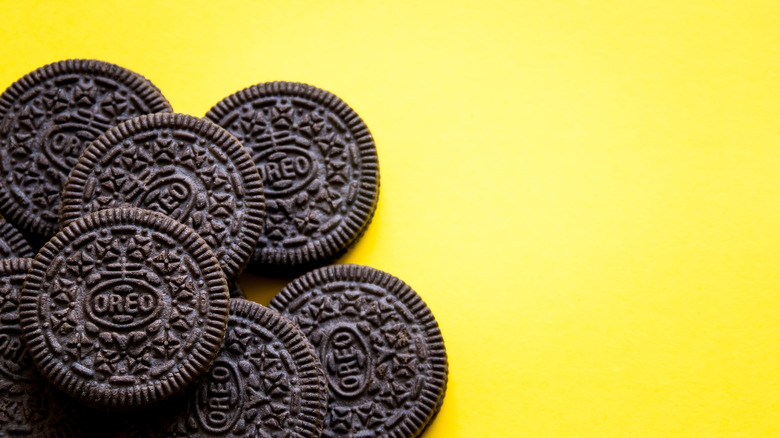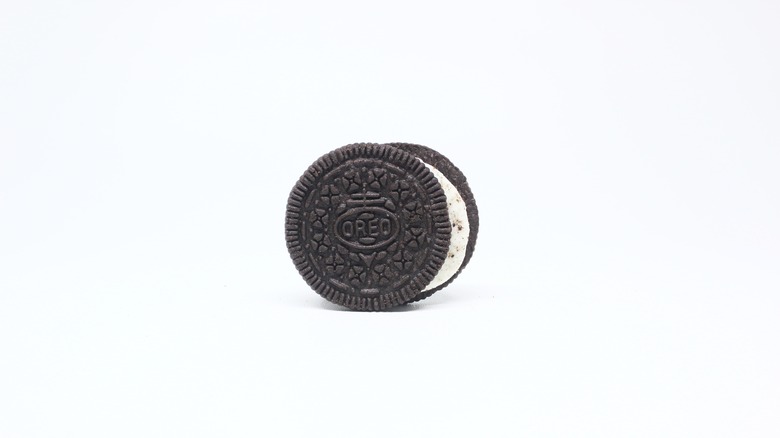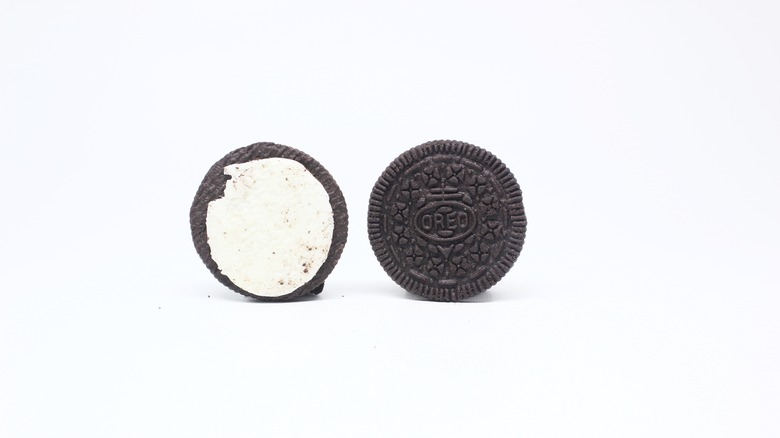Eating Oreos The 'Correct Way' Has Become A Scientific Phenomenon
Life is full of big questions. Are we alone in the universe? What happens to our consciousness when we die? What is the meaning of it all? Yet all of these great unknowns pale in comparison to the most important query of them all: How do you eat an Oreo? It seems like very few people treat these sandwich cookies like actual sandwiches, which would entail eating all three layers — cookie, creme, cookie — at once. Instead, most folks seem to prefer to separate each Oreo into halves by twisting the cookies apart. Oreo itself endorses this approach, selling a shirt printed with the instructions "Twist, Lick, Dunk."
But you can't really split an Oreo in half, can you? That middle layer of vanilla-flavored creme (not 'cream' mind you, since Oreo filling contains no dairy whatsoever) doesn't separate in the middle. It inevitably sticks to just one cookie, leaving at most a few streaks of white on the other side. Of course, this wouldn't be an issue if we simply ate Oreos as whole sandwiches ... but where's the fun in that? We created this problem for ourselves, and we have to live with it. Unless, that is, if there's some way to split an Oreo's filling exactly down the middle. A research team at the Massachusetts Institute of Technology set out to explore this possibility.
MIT scientists twisted over 1,000 Oreos
While under lockdown due to COVID-19 in 2021, Crystal Owens, a Ph.D. candidate in the MIT Department of Mechanical Engineering started thinking about Oreos. "I've always been annoyed that I have to twist them apart and then push creme from one side onto the other," she told The Wall Street Journal. She set out to find a better way. In a study titled "On Oreology, the fracture and flow of 'milk's favorite cookie®,'" co-authored with Max Fan, A. John Hart, and Gareth McKinley, Owens attempted to solve the Oreo conundrum by applying rheology — the science of flow in non-Newtonian fluids.
Non-Newtonian fluids are substances whose viscosities change depending on the forces acting upon them. Take toothpaste, for example. If you tip a tube of toothpaste upside down, the paste will not pour out, but if you apply pressure to the tube, it flows easily. Owens studies non-Newtonian fluids for potential use in 3-D printing using a device called a rheometer. It works by sandwiching a fluid material between two plates, then rotating those plates in opposite directions. Sound familiar? Owens spotted the parallel to Oreo twisting, and wondered if the rheometer could be used to split the creme filling into perfect halves. Owens and her team tested over 1,000 Oreos, twisting them at different speeds. The slowest twist took five minutes, while the fastest was estimated to be 100 times faster than a human could possibly twist.
The results were disappointing
Unfortunately, Owens and her team were never able to split the filling evenly. In fact, in 80% of their tests, it stuck entirely to one cookie. Owens believes this is because the creme forms a stronger bond with the first wafer it is applied to. The second wafer, nestled on top, doesn't exert enough force on the creme to break its structure. There are two ways to potentially change this. One would be applying both cookies to the creme at the exact same moment. Another would be to make the inner side of each wafer textured, like the outside is, to improve grip.
Owens and her team hope to use rheology to analyze similar treats such as macarons and ice cream sandwiches in the lab. They've also designed an Oreometer that anyone with a 3-D printer can make and use for their own Oreo twisting experiments. There's a real purpose to this work as well since research indicates that engaging in ritualistic behaviors with our food, such as the deliberate twisting and licking of Oreo cookies, actually enhances our enjoyment. Giving just a bit of extra time and focus to the things we eat can actually make them taste better, but perhaps there's a limit to how far we can take that. If you want perfectly halved Oreos, despite your best efforts, you'll probably be at it for the rest of your life.


